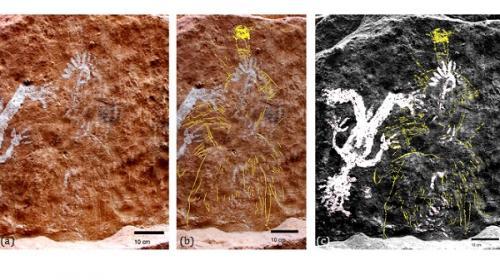Geoff Vivian /Science Network WA
Source - http://phys.org/news/2014-06-distinct-artwork-contact-period-regions.html

Scratch-work and painted rock art in the southern Kimberley (a) unenhanced panel (b) the same panel with the scratch-work highlighted to show a Wanjina like figure with headdress (c) white painted figure partially superimposed over the cratch-work shows its more recent age. Credit: Bunuba
Central Kimberley rock art from the period of first Aboriginal–European contact shows iconography dramatically different to both pre-contact art and contact art from other districts.
Archaeologist Jane Balme says this reflects the violent history of the time and place, where Jandamarra led a guerrilla action against settlers and police, and Aborigines were then obliged to work on pastoral stations.
Contact period rock art is mostly confined to charcoal drawings and images lightly scratched in the rockface.
Some traditional owner's recall seeing these made when they were children visiting these sites with their parents.
Prof Balme says this is a reflection of the limited artmaking time afforded by the annual wet season "holiday" the station managers allowed.
She has been told it also reflects the difficulty Aborigines, as pastoral workers, had in accessing traditional ochre sites to gather pigments.
Pre-contact art shows techniques that reflect seasonal migration around the artists' tribal country, including wall paintings using ochres brought from other places and prepared on site.
Prof Balme says pre-contact rock art also reflects the artists' spiritual connection to the landscape.
Wandjina paintings, for example, were created or refreshed with new pigments in order to ritually bring on the monsoons.
While these practices did not end altogether, Prof Balme says contact period art typically shows human figures dressed for ceremonies in conical head dresses and dancing.
The authors interpret this as an affirmation of the peoples' identity.
Kimberley contact art distinct from Pilbara
"What we found really surprising, unlike the Pilbara where we get lots of images of horses and people in European dress and firearms and other European motifs, there's none of that in the contact art of that region," she says.
They interpret the lack of such images in the central Kimberley as a reflection of the artists' distaste for the invaders, as opposed to the initial curiosity shown in other regional styles.
They are aware of only one painted wall at Mimbi in the eastern part of the limestone country that shows a man with a hat, a sailboat and one of the horse-drawn trams used in Derby at the time.
Together with Professor Sue O'Connor, Professor Balme has spent some years studying Bunuba and Goonyandi occupation sites in the central Kimberley limestone country which is a former Devonian coral reef.
They have co-authored one paper with local traditional owners and other local informants who grew up in the district, and are soon to publish another.
More information: "Marking resistance? Change and continuity in the recent rock art of the southern Kimberley, Australia." Sue O'Connor, et al. Antiquity, Volume: 87 Number: 336 Page: 539–554, antiquity.ac.uk/ant/087/ant0870539.htm